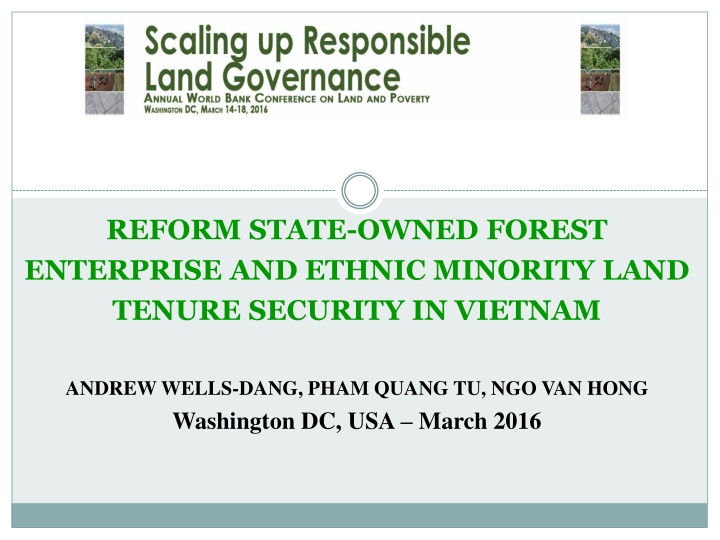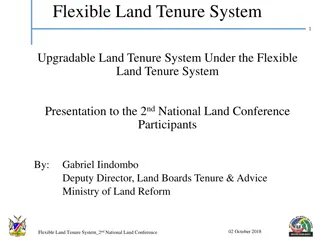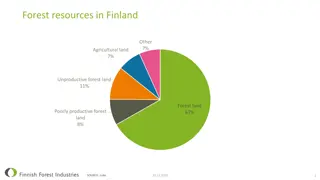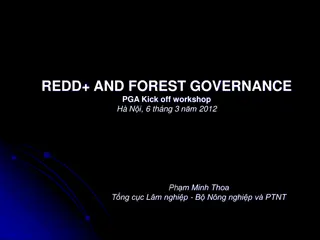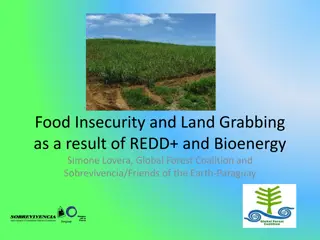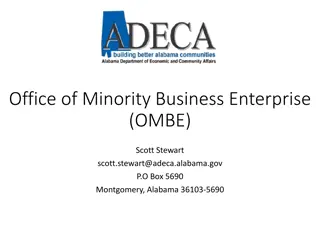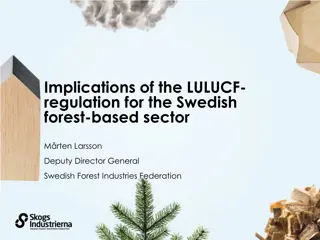Reforming State-Owned Forest Enterprises and Ensuring Ethnic Minority Land Tenure Security in Vietnam
Vietnamese government nationalized agricultural and forest land in the 1950s, impacting ethnic minority groups. Despite attempts to reform state-owned forest enterprises, conflicts over forest land persist. This study examines policies, processes, and conflicts in three provinces to offer recommendations for resolving the issues.
Download Presentation

Please find below an Image/Link to download the presentation.
The content on the website is provided AS IS for your information and personal use only. It may not be sold, licensed, or shared on other websites without obtaining consent from the author.If you encounter any issues during the download, it is possible that the publisher has removed the file from their server.
You are allowed to download the files provided on this website for personal or commercial use, subject to the condition that they are used lawfully. All files are the property of their respective owners.
The content on the website is provided AS IS for your information and personal use only. It may not be sold, licensed, or shared on other websites without obtaining consent from the author.
E N D
Presentation Transcript
REFORM STATE-OWNED FOREST ENTERPRISE AND ETHNIC MINORITY LAND TENURE SECURITY IN VIETNAM ANDREW WELLS-DANG, PHAM QUANG TU, NGO VAN HONG Washington DC, USA March 2016
Introduction Since early 1950s, Vietnamese government nationalized agricultural and forest land throughout the country. While agricultural land was de-collectivized since mid-1980s, the majority of forest and forest land has continued to be managed by state enterprises (SFEs). This process has cause problem to livelihoods of 53 ethnic minority groups Government has issue different policies to change the SFE system. However, in reality conflicts over forest land between SFEs and local people are still widely happened in Vietnam. This paper to study overall policy / process of reforming SFEs and examine land conflict in 3 provinces in order to draw out recommendation to solve the problem
Contents of presentation 1. Forest land management in Vietnam and ethnic minority land tenure 2. State-owned forest enterprises and land conflict with ethnic minority people/ community 3. Conclusions and policy recommendations
1. Forest land management in Vietnam and ethnic minority forestland tenure
Forest land management in Vietnam Vietnam: 1. Located at South-East Asia with total population of 90 million people in 54 ethnic groups (majority of Vietnamese and 53 ethnic minority groups) 2. Total forest land area of: 15,373,063 hectares, comprise of 75 % of total countries
Forestland allocation to different user groups Source: Ministry of Agriculture and Rural Development (MARD) - 2015
Ethnic minority forestland tenure 1. 53 ethnic minority people in Vietnam comprises 14 % of total population but present more than 50% of poverty in Vietnam Land and forest tenure is the most fundamental element that relates to the daily existence of ethnic minority communities People and communities manage land and forest through customary law system: 84% communities have communities forest and 60% communities manage forest by customary law According to National Assembly, in 2012 there were 347,000 ethnic minority households still lack of land. This is one of the most important reason explained why ethnic minority people still have high percentage of poverty 2. 3. 4.
2. State owned forest enterprises and land conflict with ethnic minority people
State owned forest enterprises (SFEs) in Vietnam 1. During revolution and national unification, the government nationalized agriculture and forest land to establish cooperatives and SFEs 2. End of 2014, SFEs manage 2,222,330 hectares of forestland
Critiques on performance of SFEs 1. State forest enterprises manage land inefficiently:SFE land produces $500 per hectare per year, compared to $1,350 per hectare by a small- scale farmer 2. SFEs create few jobs and make little contribution to poverty reduction: SFEs only provided 267,000 jobs (0.5% of the total national work force). Average monthly income of SFE workers is less than $100, compared to $250 for workers in private agriculture companies 3. Local people cannot access forest land for their livelihood and religious needs:In many cases, people are not even allowed to collect firewood, bamboo, or mushrooms from forests just a few meters distant from their homes. 4. Land encroachment and conflict between SFEs and local people are regular occurrences: In 2015, the total area of land under conflict between SFEs and local people is about 39,950 hectares.
Government policy towards innovation of SFEs 1. Since establishment (early 1960s) the SFEs were subsidize by the government for forest exploitation and agricultural cultivation 2. In early 1990 the government has require the SFEs to transfer operation based on the law of enterprise 3. Politburo of communist party s resolution 28-NQ/TW in 2003 to reform / innovating SFEs. However, the government has fail to implement this process 4. In 2013 the politburo continue to issue the resolution 30- NQ/TW to continue reforming SFEs and the government issue Decree 118/2014 to implement the politburo s resolution
Land conflict between SFEs and ethnic minority people About 70% of compliant in Vietnam is related to land. In 2003, there were 5,211 complaint cases, 2006 was 10,650 cases and more in following years Three case studies: Land conflicts in Lang Son province, North-eastern of VN Land and forest conflicts in Quang Binh province, Central of VN Land and forest conflicts in Lam Dong province, Central Highlands
Land conflict in Lang Son province 1. Dong Bac SFE was established in early 1960 to manage 21,825 hectares of land and forest More than 80% of local people live in the area are the Nung and Cao Lan ethnic minority people Due to lack of human resources, the Company contract to the people to plan Eucalyptus on the land. After 7 years, when plantation harvested, people have to pay 35-70 m3 of timber per hectare, without any investment from the company People blame the company as new landlord and therefore encroaching the land as well as not return land to company after harvesting In 2013, there were 17,095 hectare of land (account for 78.3%) in conflict with people 2. 3. 4. 5.
Land and forest conflict in Quang Binh province 1. Long Dai company was transfer from forestry cooperative in 1989 and manage 100,035 hectares, of which 71,000 hectares is natural forest Van Kieu ethnic minority people live in Truong Son commune, which 96 % of land is being managed by Long Dai company Local ethnic minority people only allocate about 0.8 hectares of land per household since each staff of Long Dai company manage about 1,000 hectares of land and forest In Khe Cat village: 100% household lack of land and poverty rate is 80%. People don t receive contract from the company, therefore, land conflict has been increasing Local households immediately plant cassava in the Company s most recently logged-over plantations All village households prevent the Company from reforestation The local households clear forests to produce cassava and plant eucalyptus in the area near the residential areas on the Company s land. 2. 3. 4.
Land and forest conflict in Lam Dong province 1. Loc Bac company established in 2008, to manage 32,849 hectares of land and forest About 61% of total 3,370 people in Loc Bac commune are Chau Ma ethnic minority people. 90% area of the commune managed by the company In 2008, under implementation of Communist party resolution 28, estimated 5,000 hectares of land and forest will be re- allocated for local people. However, by 2012, all of these land was allocated for 16 rubber companies from outside Land conflict has been dramatically increase and sometimes resulting in fighting such as: villagers attacked and ruined the office of rubber company and frequently submiting petitions to the local government to ask for land allocation 2. 3. 4.
2. Conclusions and Policy Recommendations
Conclusion 1. The spatial extent of conflicts over forest land is larger than that indicated by Vietnamese government statistics. In Dong Bac company the real conflict area is 17,095 hectares, compare to less than 1,000 hectares reported. Land conflicts are taking in different forms from: Submitting petition to the government, encroaching land, clearing forest of the company, preventing company to plant forest and attacking company s office... The main reason for conflicts are including: (1) Unfair in land distribution and utilization, (2) People are lacking productive land, (3) Increasing role of commercial agriculture market, and (4) Local authorities lack effective mechanism to address conflict Government has issued several policies innovate SFEs and reducing conflicts but still has not been effecting yet 2. 3. 4.
Recommendations Vietnam being implementing the politburo resolution 30- NQ/TW in 2013, it is recommend that: 1. Develop a framework for overall evaluation of the effectiveness and assessment of current land use of SFEs 2. Identify solutions and mechanisms to solve land and forest conflicts between SFEs and local people 3. Closely monitor process of re-allocating 320,000 hectares of land from SFEs to local people 4. The revision of Forestry law in 2017-2018 should ensure that communities have full rights to access to the forest after having land and forest use certificates
Recommendations 5. Vietnam need to have solutions to stop land conflicts and clearly re-identify the land boundary between each land users in order to implement and benefit from REDD+ and FLEGT VPA 6. WB in Vietnam has play an very active role in country social economic development, poverty reduction and reforming State owned economic sector. Therefore hope the Bank will also pay attention to this innovating SFEs and land conflict between SFEs and local people
Thank you very much for your attention!
